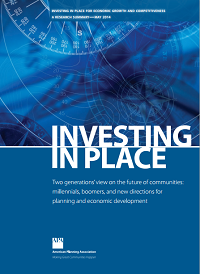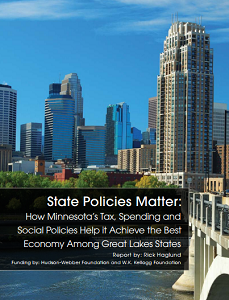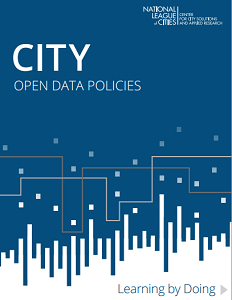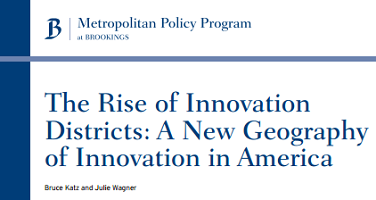Placemaking is such a buzz word of 2014 – and that’s a good thing! Placemaking awareness has been on the rise for the past few years, but themes, ideas, and policies are now more generally accepted and promoted. Placemaking is something people can relate to, want to talk about, and want to promote, which is great news for Michigan communities.
2014 has been a wonderful year for new research, stories, and perspectives on placemaking, engagement, and talent attraction throughout Michigan and across the globe. As part of the League’s services, we’ve been documenting and cataloguing articles related to our placemaking asset areas to use in presentations, guidebooks, research, and talking points. Here are my top five favorite reports of the year:
Investing In Place, American Planning Association

- Engage residents: 75% of millennials and boomers agree that engaging citizens is essential to rebuilding local economies and creating jobs
- Prioritize walkability and transit: Fewer than 10% of millennials, gen Xers, and boomers are interested in traditional, auto-dependent suburban living
- Invest in quality of life: 74% of respondents believe investing in schools, walkability, and transportation is a better way to grow the economy than traditional approaches.
Using findings from this report, community leaders can frame future investments and development plans based on the public’s interests.
The Rise of Innovation Districts, The Brookings Institute
Communities and metro regions across the country are recovering from the Great Recession, but most are still behind their pre-recession peaks. There are some areas, however, that are recovering faster and stronger. According to the report, downtowns where people both live and work grew 77% faster than the country as a whole. Similarly, metro areas with more than 1 million people grew twice as fast than areas with populations under 250,000
The report explores all aspects of innovation districts – which Brookings defines as a high density area of entrepreneurs, education and medical institutions, start-ups, and mixed-use developments that are interconnected through transit, technology, and physical proximity. The Rise of Innovation Districts says these districts are where jobs can grow faster, stronger, and more equitably, where density can reduce carbon emissions, and where local governments can generate more tax revenue. The report continues to explore the economic, physical, and networking aspects of how innovations work, as well as how community leaders can spark and scale innovation districts in their own communities.
Even for smaller communities, the report can be used as leverage to promote different areas of placemaking from entrepreneurial incentives, to walkable streets, to efficient transportation options.
State Policies Matter, Michigan Future

- Income taxes, business taxes, sales taxes, and gas taxes are all significantly higher in Minnesota, which means per capita state and local taxes are $1,000 – $5,000 higher than in Michigan.
- These higher tax revenues allow Minnesota’s government to invest more in important priorities. For example, Michigan spends $1,447/person on k-12 education, while Minnesota spends $2,067/person. Michigan spends $223/person on transportation, while Minnesota spends $465/person. And Michigan spends $119/person in local government aid, while Minnesota spends $465/person.
- Social policies are also more equitable in Minnesota than in Michigan. For example, the state allows same-sex marriages, allows affirmative action for college admissions, and allows undocumented high school graduates to receive in-state tuition at state universities.
This report can be seen as a timely warning to our state and local leaders to reconsider some current policy priorities.
The Equity Solution, PolicyLink
This fall, PolicyLink launched the National Equity Atlas, an online resource of demographics and economic data across the US with policy implications focused on racial equality. This data highlights the persistent, and often growing gaps, between the rich and poor, and white and non-white populations. Some important findings include:
Racial economic inclusion could annually add $2 trillion to the national economy
- 66% of racial income gap is due to wage differences, and only 34% is due to employment differences
- Every region in the country would be stronger with racial inclusion. Potential annual gains range from $287 million to $510 billion in the nation’s 150 largest metro regions.
Users can manipulate data on the National Equality Atlas site to represent findings from their state or region. Michigan can be looked at as a whole or in the Ann Arbor, Detroit, Flint, Grand Rapids, Kalamazoo, and Lansing regions.
The report also highlights policy recommendations for closing economic gaps between racial lines. Some examples include:
- Invest in transit and other infrastructure projects to improve connectivity and create jobs
- Leverage anchor institutions to grow new business in underinvested areas
- Raise the minimum wage through local living wage ordinances or statewide initiatives
- Remove barriers of employment, like prohibiting credit checks for job applicants and increasing citizenship for immigrants.
City Open Data Policies, National League of Cities

Jackson is the only Michigan community, so far, to venture into the possibilities of open data. With work from city leaders, student interns, and national institutional advisors, Jackson has already adopted an open data ordinance and is currently working on creating an online portal. Communities interested in learning more are encouraged to contact Jackson and take recommendations from the NLC report:
- Find leadership for open data initiatives
- Commit to open data through legislation and formal policies
- Allocate resources to open data initiatives – although it’s low cost, the best policies have appropriate staffing and budgeting
- Rely on experts to provide technical expertise and customer service for online platforms since municipalities often don’t have the in-house resources readily available
So what are you supposed to do with these five reports?
Read them, share them, and use them to make decisions in your community. And if you want more light reading for the holiday break, just let me know! Since April, we have been cataloging interesting articles, reports, and case studies related to placemaking. So far we have about 200 in our database, so there’s plenty to keep you busy.
Looking forward to another year of research, placemaking, and community building!

